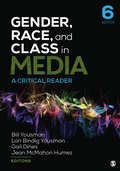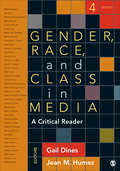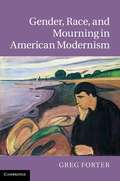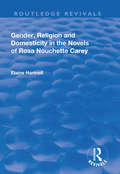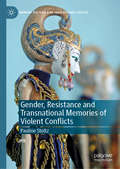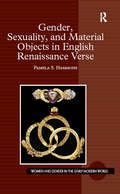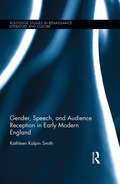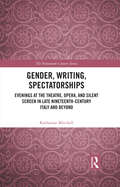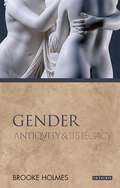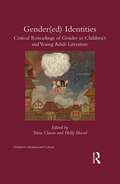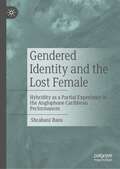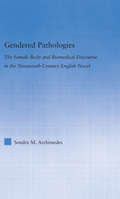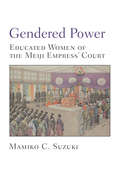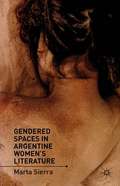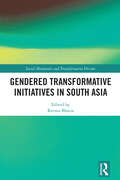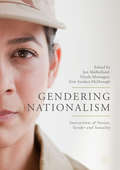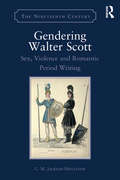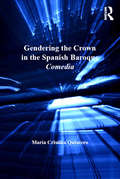- Table View
- List View
Gender, Race, and Class in Media: A Critical Reader
by Gail Dines Bill Yousman Lori Bindig Yousman Jean McMahon HumezGender, Race, and Class in Media provides students a comprehensive and critical introduction to media studies by encouraging them to analyze their own media experiences and interests. Editors Bill Yousman, Lori Bindig Yousman, Gail Dines, and Jean McMahon Humez explore some of the most important forms of today&’s popular culture—including the Internet, social media, television, films, music, and advertising—in three distinct but related areas of investigation: the political economy of production, textual analysis, and audience response. Multidisciplinary issues of power related to gender, race, and class are integrated into a wide range of articles examining the economic and cultural implications of mass media as institutions. Reflecting the rapid evolution of the field, the Sixth Edition includes 18 new readings that enhance the richness, sophistication, and diversity that characterizes contemporary media scholarship.
Gender, Race, and Class in Media: A Critical Reader
by Gail Dines Bill Yousman Lori Bindig Yousman Jean McMahon HumezGender, Race, and Class in Media provides students a comprehensive and critical introduction to media studies by encouraging them to analyze their own media experiences and interests. Editors Bill Yousman, Lori Bindig Yousman, Gail Dines, and Jean McMahon Humez explore some of the most important forms of today&’s popular culture—including the Internet, social media, television, films, music, and advertising—in three distinct but related areas of investigation: the political economy of production, textual analysis, and audience response. Multidisciplinary issues of power related to gender, race, and class are integrated into a wide range of articles examining the economic and cultural implications of mass media as institutions. Reflecting the rapid evolution of the field, the Sixth Edition includes 18 new readings that enhance the richness, sophistication, and diversity that characterizes contemporary media scholarship.
Gender, Race, and Class in Media: A Critical Reader (Fourth Edition)
by Gail Dines Jean M. HumezThis provocative new edition of Gender, Race, and Class in Media engages students with a comprehensive introduction to mass media studies. <P><P>Editors Gail Dines and Jean M. Humez present new and classic readings that critically analyze some of the most pervasive and influential forms of media entertainment culture, including advertising, reality tv shows, sitcoms and dramatic series, pornography, fan and celebrity gossip websites, videogames and online social media and virtual reality enterprises. <P>Issues of power related to gender, race, class and sexuality are integrated into a wide range of compelling articles examining the economic and cultural implications of mass media as institutions, such as the political economy of media production, textual analysis, and media consumption, including current questions raised by fan participation in production and distribution.
Gender, Race, and Mourning in American Modernism
by Greg ForterAmerican modernist writers' engagement with changing ideas of gender and race often took the form of a struggle against increasingly inflexible categories. Greg Forter interprets modernism as an effort to mourn a form of white manhood that fused the 'masculine' with the 'feminine'. He argues that modernists were engaged in a poignant yet deeply conflicted effort to hold on to socially 'feminine' and racially marked aspects of identity, qualities that the new social order encouraged them to disparage. Examining works by F. Scott Fitzgerald, Ernest Hemingway, William Faulkner and Willa Cather, Forter shows how these writers shared an ambivalence toward the feminine and an unease over existing racial categories that made it difficult for them to work through the loss of the masculinity they mourned. Gender, Race, and Mourning in American Modernism offers a bold new reading of canonical modernism in the United States.
Gender, Religion and Domesticity in the Novels of Rosa Nouchette Carey
by Elaine HartnellThis title was first published in 2000. Rosa Nouchette Carey (1840-1909), the English author of forty-one ’domestic’ novels, was continuously in print from 1868 until at least 1924 and yet she is virtually unknown today. This first in-depth study of Carey’s work assesses both her immense popularity and her subsequent fall from favour. Organized thematically, it engages with the historical and cultural context of the novels as well as comparing them with the work of Carey’s contemporaries. Matters such as Carey’s creative response towards spinsterhood, her provision of vicarious male approval and her valorization of housework are perceived as functions of her writing that lie beyond formal literary criticism. This is not to deny the literary value of Carey’s work; rather it is to make intelligible its value to a large and enthusiastic readership despite an undoubted lack of appreciation on the part of reviewers.
Gender, Resistance and Transnational Memories of Violent Conflicts (Memory Politics and Transitional Justice)
by Pauline StoltzThis book investigates the importance of gender and resistance to silences and denials concerning human rights abuses and historical injustices in narratives on transnational memories of three violent conflicts in Indonesia. Transnational memories of violent conflicts travel abroad with politicians, postcolonial migrants and refugees. Starting with the Japanese occupation of Indonesia (1942–1945), the war of independence (1945–1949) and the genocide of 1965, the volume analyses narratives in Dutch and Indonesian novels in relation to social and political narratives (1942–2015). By focusing on gender and resistance from both Indonesian and Dutch, transnational and global perspectives, the author provides new perspectives on memories of the conflicts that are relevant to research on transitional justice and memory politics.
Gender, Sex and Translation: The Manipulation of Identities
by Jose SantaemiliaGendered and sexual identities are unstable constructions which reveal a great deal about the ideologies and power relatinships affecting individuals and societies. The interaction between gender/sex studies and translation studies points to a fascinating arena of discursive conflict in which our intimate desires and identities are established or rejected, (re)negotiated or censored, sanctioned or tabooed. This volume explores diverse and heterogeneous aspects of the manipulation of gendered and sexual identities. Contributors examine translation as a feminist practice and/or theory; the importance of gender-related context in translation; the creation of a female image of secondariness through dubbing and state censoriship; attempts to suppress the blantantly patriarchal and sexist references in the German dubbed versions of James Bond films; the construction of national heroism and national identity as male preserve; the enactment of Chamberlain's 'gender metaphorics' in Scliar and Calvino; the transformation of Japanese romance fiction through Harlequin translations; the translations of the erotic as site for testing the complex rewriting(s) of identity in sociohistorical term; and the emergence of NRTs (New Reproductive Technologies), which is causing fundamental changes in the perception of 'creativity' or 'procreation' as male domains.
Gender, Sex, and the City: Urdu Rekhti Poetry in India, 1780-1870
by Ruth VanitaExplores the urban, cosmopolitan sensibilities of Urdu poetry written in the late eighteenth and early nineteenth centuries in Lucknow. Ruth Vanita analyzes Rekhti, a type of Urdu poetry distinguished by a female speaker and a focus on women's lives, and shows how it becamea catalyst for the transformation of the ghazal.
Gender, Sexuality, and Material Objects in English Renaissance Verse (Women and Gender in the Early Modern World)
by Pamela S. HammonsAn important contribution to recent critical discussions about gender, sexuality, and material culture in Renaissance England, this study analyzes female- and male-authored lyrics to illuminate how gender and sexuality inflected sixteenth- and seventeenth-century poets' conceptualization of relations among people and things, human and non-human subjects and objects. Pamela S. Hammons examines lyrics from both manuscript and print collections”including the verse of authors ranging from Robert Herrick, John Donne, and Ben Jonson to Margaret Cavendish, Lucy Hutchinson, and Aemilia Lanyer”and situates them in relation to legal theories, autobiographies, biographies, plays, and epics. Her approach fills a crucial gap in the conversation, which has focused upon drama and male-authored works, by foregrounding the significance of the lyric and women's writing. Hammons exposes the poetic strategies sixteenth- and seventeenth-century English women used to assert themselves as subjects of property and economic agents”in relation to material items ranging from personal property to real estate”despite the dominant patriarchal ideology insisting they were ideally temporary, passive vehicles for men's wealth. The study details how women imagined their multiple, complex interactions with the material world:the author shows that how a woman poet represents herself in relation to material objects is a flexible fiction she can mobilize for diverse purposes. Because this book analyzes men's and women's poems together, it isolates important gendered differences in how the poets envision human subjects' use, control, possession, and ownership of things and the influences, effects, and power of things over humans. It also adds to the increasing evidence for the pervasiveness of patriarchal anxieties associated with female economic agency in a culture in which women were often treated as objects.
Gender, Space, and the Gaze in Post-Haussmann Visual Culture: Beyond the Flâneur
by Temma BalducciCharles Baudelaire’s flâneur, as described in his 1863 essay "The Painter of Modern Life," remains central to understandings of gender, space, and the gaze in late nineteenth-century Paris, despite misgivings by some scholars. Baudelaire’s privileged and leisurely figure, at home on the boulevards, underlies theorizations of bourgeois masculinity and, by implication, bourgeois femininity, whereby men gaze and roam urban spaces unreservedly while women, lacking the freedom to either gaze or roam, are wedded to domesticity. In challenging this tired paradigm and offering fresh ways to consider how gender, space, and the gaze were constructed, this book attends to several neglected elements of visual and written culture: the ubiquitous male beggar as the true denizen of the boulevard, the abundant depictions of well-to-do women looking (sometimes at men), the popularity of windows and balconies as viewing perches, and the overwhelming emphasis given by both male and female artists to domestic scenes. The book’s premise that gender, space, and the gaze have been too narrowly conceived by a scholarly embrace of Baudelaire’s flâneur is supported across the cultural spectrum by period sources that include art criticism, high and low visual culture, newspapers, novels, prescriptive and travel literature, architectural practices, interior design trends, and fashion journals.
Gender, Speech, and Audience Reception in Early Modern England (Routledge Studies in Renaissance Literature and Culture)
by Kathleen Kalpin SmithThis book makes a significant contribution to recent scholarship on the ways in which women responded to the regulation of their behavior by focusing on representations of women speakers and their audiences in moments Smith identifies as "scenes of speech." This new approach, examining speech exchanges between a speaker and audience in which both anticipate, interact with, and respond to each other and each other's expectations, demonstrates that the prescriptive process involves a dynamic exchange in which each side plays a role in establishing and contesting the boundaries of acceptable speech for women. Drawing from a wide range of evidence, including pamphlets, diaries, illustrations, and plays, the book interprets the various and at times contradictory representations and reception of women’s speech that circulated in early modern England. Speech scenes examined within include wives' speech to their husbands in private, private speech between women, public speech before death, and the speech of witches. Looking at scenes of women’s speech from male and female authors, Smith argues that these early modern texts illustrate a means through which societal regulations were negotiated and modified. This book will appeal to those with an interest in early modern drama, including the playwrights Shakespeare, Cary, Webster, Fletcher, and Middleton, as well as readers of non-dramatic early modern literary texts. The volume is of particular use for scholars working in the areas of early modern literature and culture, women’s history, gender studies, and performance studies.
Gender, Writing, Spectatorships: Evenings at the Theatre, Opera, and Silent Screen in Late Nineteenth-Century Italy and Beyond (The Nineteenth Century Series)
by Katharine MitchellThis original study makes a valuable contribution to Italian feminist/women’s history, spectatorship studies, and cultural history by examining women as protagonists, producers and consumers of literature, theatre, opera and film. Drawing on archival material – female correspondence, life-writings and journalism – as well as an impressive range of canonical texts, it brings together detailed engagement with female performance and with female spectators’ material responses to "women’s opera, theatre and film," placing these in the context of melodrama from the 1880s to the 1920s in Italy, France, the US, and elsewhere. It is unique in its interdisciplinary approach and in its consideration of female relationships based on admiration among performers and writers – the embodiment of a vibrant, mobile and successful Italian female culture industry during the first wave of feminism.
Gender, the New Woman, and the Monster
by Elizabeth D. MacalusoThis book views late Victorian femininity, the New Woman, and gender through literary representations of the figure of the monster, an appendage to the New Woman. The monster, an aberrant occurrence, performs Brecht’s “alienation effect,” making strange the world that she inhabits, thereby drawing veiled conclusions about the New Woman and gender at the end of the fin-de-siècle. The monster reveals that New Women loved one another complexly, not just as “friend” or “lover,” but both “friend” and “lover.” The monster, like the fin-de-siècle British populace, mocked the New Woman’s modernity. She was paradoxically viewed as a threat to society and as a role model for women to follow. The tragic suicides of “monstrous” New Women of color suggest that many fin-de-siècle authors, especially female authors, thought that these women should be included in society, not banished to its limits. This book, the first on the relationship between the figure of the monster and the New Woman, argues that there is hidden complexity to the New Woman. Her sexuality was complicated and could move between categories of sexuality and friendship for late Victorian women, and the way that the fin-de-siècle populace viewed her was just as multifarious. Further, the narratives of her tragedies ironically became narratives that advocated for her survival.
Gender: Antiquity And Its Legacy (Ancients And Moderns Ser.)
by Brooke HolmesGender has now become a pervasive topic in the humanities and social sciences. Yet despite its familiarity within universities and colleges, some have argued that the radical debates which first characterized gender studies have become ghettoized or marginalized -- so that gender no longer makes the impact on creative thinking and ideas that it once did. Brooke Holmes here rescues ancient ideas about sex and gender in order precisely to reinvigorate contemporary debate. She argues that much writing on gender in the classical age fails to place those ancient ideas within their proper historical contexts. As a result, the full transformational force of that thinking is often overlooked. In this short, lively book, the author offers a sophisticated and historically rounded reading of gender in antiquity in order to map out the future of contemporary gender studies. By re-examining ancient notions of sexual difference, bodies, culture, and identity, Holmes shows that Plato, Aristotle, the Stoics, Epicureans and others force us to reassess what is at stake in present-day discussions about gender. The ancient world thus offers a vital resource for modern gender theory.
Gender: Critical Rereadings of Gender in Children's and Young Adult Literature (Children's Literature and Culture)
by Tricia Clasen and & Holly HasselThis volume brings together diverse, cross-disciplinary scholarly voices to examine gender construction in children's and young adult literature. It complements and updates the scholarship in the field by creating a rich, cohesive examination of core questions around gender and sexuality in classic and contemporary texts. By providing an expansive treatment of gender and sexuality across genres, eras, and national literature, the collection explores how readers encounter unorthodox as well as traditional notions of gender. It begins with essays exploring how children's and YA literature construct communities formed by gender, ethnicity, sexuality, and in face-to-face and virtual spaces. Section II's central focus is how gendered identities are formed, unpacking how texts for young readers ranging from Amish youth periodicals to the blockbuster Divergent series trace, reproduce, and shape gendered identity socialization. In section III, the essential literary function of translating trauma into narrative is addressed in classics like Anne of Green Gables and Pollyanna, as well as more recent works. Section IV's focus on sexuality and romance encompasses fiction and nonfiction works, examining how children's and young adult literature can serve as a regressive, progressive, and transgressive site for construction meaning about sex and romance. Last, Section IV offers new readings of paratextual features in literature for children -- from the classic tale of Cinderella to contemporary illustrated novels. The key achievement of this volume is providing an updated range of multidisciplinary and methodologically diverse analyses of critically and commercially successful texts, contributing to the scholarship on children's and YA literature; gender, sexuality, and women's studies; and a range of other disciplines.
Gendered Identity and the Lost Female: Hybridity as a Partial Experience in the Anglophone Caribbean Performances
by Shrabani BasuThis book offers an exploration of the postcolonial hybrid experience in anglophone Caribbean plays and performance from a feminist perspective.In a hitherto unattempted consideration of Caribbean theatre and performance, this study of gendered identities chronicles the postcolonial hybrid experience – and how it varies in the context of questions of sex, performance and social designation. In the process, it examines the diverse performances of the anglophone Caribbean. The work includes works by Caribbean anglophone playwrights like Derek Walcott, Mustapha Matura, Michael Gikes, Dennis Scott, Trevor Rhone, Earl Lovelace and Errol John with more recent works of Pat Cumper, Rawle Gibbons and Tony Hall. The study would also engage with Carnival, calypso and chutney music, while commenting on its evolving influences over the hybrid imagination.Each section covers the dominant socio-political thematics associated with the tradition and its effect on it, followed by an analysis of contemporaneously significant literary and cultural works – plays, carnival narrative and calypso and chutney lyrics as well as the experiences of performers. From Lovelace’s fictional Jestina to the real-life Drupatee, the book critically explores the marginalization of female performances while forming a hybrid identity.
Gendered Pathologies: The Female Body and Biomedical Discourse in the Nineteenth-Century English Novel (Literary Criticism and Cultural Theory)
by Sondra ArchimedesGendered Pathologies examines nineteenth-century literary representations of the pathologized female body in relation to biomedical discourses about gender and society in Victorian England. According to medical and scientific views of the period, the woman who did not conform to the dictates of gender ideology was, biologically speaking, aberrant: a deviation from the norm. Yet, although marginalized in a social sense, the "deviant" woman was central as a literary and cultural trope. Analyzing novels by Charles Dickens, H. Rider Haggard, and Thomas Hardy alongside Foucault's notion of perverse sexualities and Herbert Spencer's model of the social organism, Archimedes argues that the pathologized female body displaces or resolves, on a narrative level, larger cultural anxieties about the health of the British as a species. While earlier feminist investigations asserted that bourgeois ideology helped to construct scientific discourses about female sexuality and social behavior, this study takes these assertions as a starting point . Examining incest, racial stereotyping, and neurasthenia, Gendered Pathologies attempts to shed light on the ways in which biological thinking permeated British culture in the second half of the nineteenth century.
Gendered Power: Educated Women of the Meiji Empress' Court (Michigan Monograph Series in Japanese Studies #86)
by Mamiko SuzukiGendered Power sheds light on the sources of power for three prominent women of the Meiji period: Meiji Empress Haruko; public speaker, poet, and diarist Nakajima Shoen; and educator and prolific author Shimoda Utako. By focusing on the role Chinese classics (kanbun) played in the language employed by elite women, the chapters focus on how Empress Haruko, Shoen, and Shimoda Utako contributed new expectations for how women should participate in a modernizing Japan. By being in the public eye, all three women countered criticism of and commentary on their writings and activities, which they parried by navigating gender constraints. The success or failure as women ascribed to these three figures sheds light on the contradictions inhabited by them during a transformative period for Japanese women. By proposing and interrogating the possibility of Meiji women’s power, the book examines contradictions that were symptomatic of their struggles within the vast social, cultural, and political transformations that took place during the period. The book demonstrates that an examination of that conflict within feminist history is crucial in order to understand what radical resistance meant in the face of women-centered authority.
Gendered Spaces in Argentine Women’s Literature
by Marta SierraAddressing the issue of how gendered spatial relations impact the production of literary works, this book discusses gender implications of spatial categories: the notions of home and away, placement and displacement, dwelling and travel, location and dislocation, and the 'quest for place' in women's writing from Argentina from 1920 to the present.
Gendered Technology in Translation and Interpreting: Centering Rights in the Development of Language Technology (ISSN)
by Esther Monzó-Nebot Vicenta Tasa-FusterThis collection takes an interdisciplinary approach to the study of gendered technology, an emerging area of inquiry that draws on a range of fields to explore how technology is designed and used in a way that reinforces or challenges gender norms and inequalities.The volume explores different perspectives on the impact of technology on gender relations through specific cases of translation and interpreting technologies. In particular, the book considers the slow response of legal frameworks in dealing with the rise of language-based technologies, especially machine translation and large language models, and their impacts on individual and collective rights. Part I introduces the study of gendered technologies at this intersection of legal and translation and interpreting research, before moving into case studies of specific technologies. The cases explored in Parts II and III discuss the impact of interpreting and translation technologies on language professionals, language communities, and gender inequalities, while stressing the future needs of gendered technology, particularly machine translation. Taken together, the collection demonstrates the value of a cross-disciplinary approach in better understanding how language technologies can be harnessed to address discrimination and contribute to growing discussions on gender equality and social justice at the intersection of technology and translation.This book will be of interest to scholars in translation and interpreting studies, gender studies, language technologies, and language and the law.
Gendered Transformative Initiatives in South Asia (Social Movements and Transformative Dissent)
by Reema BhatiaThis volume discusses gendered transformative initiatives in South Asian feminism, discussing gender norms, labour and market participation by women, along with family planning, reproductive rights and initiatives for the social and financial empowerment of women in South Asia.Gender is a part of our everyday lived reality. It has been one of the key structuring principles of social interaction across societies. The context may be specific to a society, but it is also universal since it intertwines with everyone’s lives. This book uses a bricoleur approach to understanding gender as a lived experience. These explorations examine the ways in which gendered identity is negotiated and lived. The volume uses a multi-methodological and multidisciplinary approach to discuss issues around conflict, work, queer identities, intersectionality and single women across Pakistan, Sri Lanka and Bangladesh.Part of the Social Movements and Transformative Dissent series, this volume will be of interest to students and researchers of gender studies, women’s studies, sociology, economics, development studies, political science, cultural studies and South Asian studies.
Gendering Nationalism: Intersections Of Nation, Gender And Sexuality
by Nicola Montagna Jon Mulholland Erin Sanders-McDonaghThis volume offers an empirically rich, theoretically informed study of the shifting intersections of nation/alism, gender and sexuality. Challenging a scholarly legacy that has overly focused on the masculinist character of nationalism, it pays particular attention to the people and issues less commonly considered in the context of nationalist projects, namely women and sexual minorities. Bringing together both established and emerging researchers from across the globe, this multidisciplinary and comparison-rich volume provides a multi-sited exploration of the shifting contours of belonging and Otherness generated by multifarious nationalisms. The diverse, and context specific positionings of men and women, masculinities and femininities, and hegemonic and non-normative sexualities, vis-à-vis nation/alism, are illuminated through a vibrant array of contemporary theoretical lenses. These include historical and feminist institutionalism, post-colonial theory, critical race approaches, transnational and migration theory and semiotics.
Gendering Walter Scott: Sex, Violence and Romantic Period Writing (The Nineteenth Century Series)
by C.M. Jackson-HoulstonEmploying gender as a unifying critical focus, Caroline Jackson-Houlston draws on the full range of Walter Scott’s novels to propose new links between Scott and Romantic-era authors such as Sophia Lee, Jane Porter, Jane Austen, Sydney Owenson, Elizabeth Hands, Thomas Love Peacock, and Robert Bage. In Scott, Jackson-Houlston suggests, sex and violence are united in a central feature of the genre of romance, the trope of raptus—the actual or threatened kidnapping of a woman and her subjection to physical or psychic violence. Though largely favouring the Romantic-period drive towards delicacy of subject-matter and expression, Scott also exhibited a residual sympathy for frankness and openness resisted by his publishers, especially towards the end of his career, when he increasingly used the freedoms inherent in romance as a mode of narrative to explore and critique gender assumptions. Thus, while Scott’s novels inherit a tradition of chivalric protectiveness towards women, they both exploit and challenge the assumption that a woman is always essentially definable as a potential sexual victim. Moreover, he consistently condemns the aggressive male violence characteristic of older models of the hero, in favour of restraint and domesticity that are not exclusively feminine, but compatible with the Scottish Enlightenment assumptions of his upbringing. A high proportion of Scott’s female characters are consistently more rational than their male counterparts, illustrating how he plays conflicting concepts of sexual difference off against one another. Jackson-Houlston illuminates Scott’s ambivalent reliance on the attractions of sex and violence, demonstrating how they enable the interrogation of gender convention throughout his fiction.
Gendering the Crown in the Spanish Baroque Comedia (New Hispanisms: Cultural and Literary Studies)
by María Cristina QuinteroThe Baroque Spanish stage is populated with virile queens and feminized kings. This study examines the diverse ways in which seventeenth-century comedias engage with the discourse of power and rulership and how it relates to gender. A privileged place for ideological negotiation, the comedia provided negative and positive reflections of kingship at a time when there was a perceived crisis of monarchical authority in the Habsburg court. Author MarÃa Cristina Quintero explores how playwrights such as Pedro Calderón de la Barca, Tirso de Molina, Antonio Coello, and Francisco Bances Candamo--taking inspiration from legend, myth, and history--repeatedly staged fantasies of feminine rule, at a time when there was a concerted effort to contain women's visibility and agency in the public sphere. The comedia's preoccupation with kingship together with its obsession with the representation of women (and women's bodies) renders the question of royal subjectivity inseparable from issues surrounding masculinity and femininity. Taking into account theories of performance and performativity within a historical context, this study investigates how the themes, imagery, and language in plays by Calderón and his contemporaries reveal a richly paradoxical presentation of gendered monarchical power.
Gendering the Renaissance: Text and Context in Early Modern Italy (The Early Modern Exchange)
by Suzanne Magnanini Courtney Quaintance Michael Sherberg Meredith K. Ray Lynn Lara Westwater Nathalie Hester Anna Wainwright Gabriella Zarri Emanuela Zanotti Carney Jennifer HaraguchiThe essays in this volume revisit the Italian Renaissance to rethink spaces thought to be defined and certain: from the social spaces of convent, court, or home, to the literary spaces of established genres such as religious plays or epic poetry. Repopulating these spaces with the women who occupied them but have often been elided in the historical record, the essays also remind us to ask what might obscure our view of texts and archives, what has remained marginal in the texts and contexts of early modern Italy and why. The contributors, suggesting new ways of interrogating gendered discourses of genre, identities, and sanctity, offer a complex picture of gender in early modern Italian literature and culture. Read in dialogue with one another, their pieces provide a fascinating survey of currents in gender studies and early modern Italian studies and point to exciting future directions in these fields.
